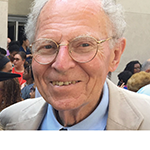
Dr. Plotz
Rheumatologists who are outstanding clinicians, provide consistently exceptional care to patients and serve as role models for colleagues and trainees are in the spotlight in our Lessons from a Master Clinician series. Here, we offer insights from clinicians who have achieved a level of distinction in the field of rheumatology.
Paul Plotz, MD, is scientist emeritus of the National Institutes of Health (NIH) and served as chief, scientific director and deputy director of the Arthritis and Rheumatism Branch of the National Institute of Arthritis and Musculoskeletal and Skin Diseases (NIAMS). He was also appointed as a senior advisor to Deputy Director for Intramural Research Michael Gottesman. Dr. Plotz worked at the NIH for 40 years, with the exception of two years when he did basic research in immunology at the National Institute for Medical Research at Mill Hill, London.
Dr. Plotz’s early work was largely in immunology. He studied the biology of immune complexes in patients, animals and in vitro with stable model immune complexes using affinity labeling polymeric antigens that he invented.
He has published extensively and lectured widely, and his awards include being named a Master of the American College of Physicians.
TR: What are the characteristics of a master clinician?
Dr. Plotz: The master clinician should:
- Pay attention to every detail of the patient’s history and to additional details that the house staff and senior staff have uncovered;
- Listen without interrupting;
- Ask questions not presented by the attending staff; and
- Focus on critical details and bring out the knowledge of the disease path that those details suggest.
Here, for example, are some instances from my own experience:
A patient was presented as having pernicious anemia, but he could stand on one foot without falling, which made the diagnosis of pernicious anemia highly unlikely.
In another case, a patient of A. Stone Freedberg, MD, presented with a density in his chest X-ray. Dr. Freedberg noted the patient had very dirty nails and fingers and that when he coughed he held his hand to his open mouth. From this, Dr. Freedberg inferred the lung density was caused by aspiration of dirt from the patient’s hand, as verified by a lung biopsy.
TR: What qualities distinguish the master clinician as a role model?
Dr. Plotz: The master clinician:
- Asks questions;
- Exhibits warmth toward the patient. Here I must relate my own experience of watching John Decker, MD, sit on a patient’s bed and touch the patient, seemingly inconsequently, and feeling and identifying a calf abscess.
- Uncovers details, historical or physical, even something like tears in the eyes of a patient, even details of accent or grammar;
- Is aware of respected norms;
- Always checks and rechecks diagnostic tests, such as X-rays and the neurological exam;
- Continuously grows in knowledge by taking all opportunities to listen to great diagnosticians (e.g., Raymond Adams, MD). Here I must cite my own obligation to such great Beth Israel, [Boston], master physicians as Dr. Freedberg and Paul Zoll, MD; and
- Avoids criticizing colleagues at the bedside, especially younger colleagues, students and house staff.
TR: Indeed, Dr. Freedberg, the former chair of cardiology at Beth Israel Hospital, had a lasting impact on Dr. Plotz and inspired many other students and clinicians as a phenomenal teacher and diagnostician. In 2009, The New York Times Magazine memorialized Dr. Freedberg at the time of his passing with the following description of what made him so special:
“As a doctor, Freedberg took extensive histories of patients that included not just physical details but also existential ones. What were their worries? Their anxieties? He stressed that exams should begin the instant patients walk through the door. How do they compose themselves? How do they walk and sit down? To Freedberg, every ache was a mystery to be solved, every piece of information a possible clue.